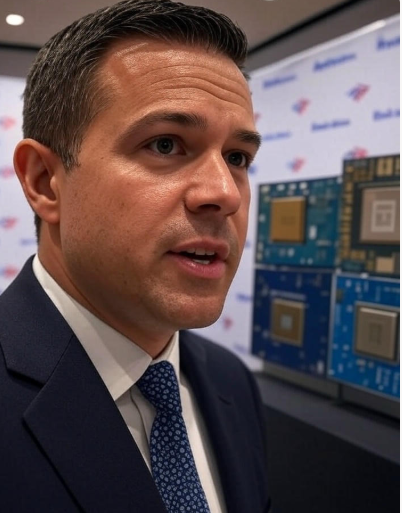Introduction
The AI industry is on the brink of a monumental leap forward. In a groundbreaking announcement reported by Bloomberg on March 6, 2025, OpenAI and Oracle have revealed their collaboration on a project that could redefine the boundaries of artificial intelligence. The centerpiece of this ambitious endeavor is the development of a state-of-the-art AI supercomputer, codenamed “Stargate,” which will be powered by billions of dollars worth of Nvidia chips. This project not only underscores the growing importance of AI in shaping the future but also highlights the critical role of cutting-edge hardware in enabling next-generation AI capabilities.
In this blog post, we’ll delve into the details of this exciting development, explore the implications for the AI industry, and discuss why Nvidia’s chips are at the heart of this transformative project.
The Stargate Project: A New Era for AI
The Stargate project represents a significant milestone in the evolution of AI infrastructure. OpenAI, a leader in AI research and development, has partnered with Oracle, a global powerhouse in cloud computing and enterprise software, to build what could become the most powerful AI supercomputer in the world. The goal of Stargate is to push the boundaries of AI capabilities, enabling breakthroughs in areas such as natural language processing, computer vision, robotics, and scientific research.
At the core of this project is the need for unprecedented computational power. Training advanced AI models, particularly large language models (LLMs) like OpenAI’s GPT series, requires massive amounts of data and processing capacity. Stargate aims to provide the infrastructure necessary to train models that are orders of magnitude larger and more sophisticated than anything currently in existence.
Why Nvidia Chips Are Indispensable
Nvidia, a leader in GPU (graphics processing unit) technology, has long been the go-to provider for AI and machine learning workloads. The company’s chips are renowned for their ability to handle parallel processing tasks efficiently, making them ideal for training complex AI models. Here’s why Nvidia’s hardware is central to the Stargate project:
- Unmatched Performance: Nvidia’s latest GPUs, such as the H100 Tensor Core GPU, are specifically designed for AI workloads. They offer exceptional performance in terms of speed and efficiency, enabling faster training times and more complex model architectures.
- Scalability: The Stargate supercomputer will require thousands, if not millions, of GPUs working in tandem. Nvidia’s ecosystem, including its NVLink and InfiniBand technologies, allows for seamless scaling of GPU clusters, ensuring that the supercomputer can handle the immense computational demands of next-generation AI models.
- Software Ecosystem: Nvidia’s CUDA platform and AI-specific libraries, such as TensorRT and cuDNN, provide developers with the tools they need to optimize AI workloads. This software-hardware synergy is critical for maximizing the performance of the Stargate supercomputer.
- Energy Efficiency: As AI models grow in size, so does their energy consumption. Nvidia’s chips are designed to deliver high performance while minimizing power usage, a crucial consideration for a project of this scale.
The decision to invest billions in Nvidia chips underscores the importance of hardware in the AI race. While algorithms and data are essential, the hardware that powers them is equally critical. Nvidia’s dominance in this space makes it the natural choice for a project as ambitious as Stargate.
Implications for the AI Industry
The Stargate project has far-reaching implications for the AI industry and beyond. Here are some key areas where its impact will be felt:
- Accelerating AI Research: By providing researchers with access to unparalleled computational resources, Stargate will accelerate the pace of AI innovation. This could lead to breakthroughs in areas such as AGI (artificial general intelligence), drug discovery, climate modeling, and more.
- Raising the Bar for Competitors: The sheer scale of the Stargate project sets a new benchmark for AI infrastructure. Other tech giants, such as Google, Amazon, and Microsoft, may feel compelled to invest in similar initiatives to remain competitive.
- Democratizing AI: While Stargate itself is a proprietary project, the advancements it enables could trickle down to smaller organizations and startups. OpenAI has a history of open-sourcing its research, and the insights gained from Stargate could benefit the broader AI community.
- Economic and Geopolitical Implications: The race for AI supremacy has significant economic and geopolitical ramifications. By investing heavily in AI infrastructure, the U.S. is positioning itself as a global leader in this critical field. However, this could also intensify competition with other nations, particularly China, which is also making substantial investments in AI.
- Ethical Considerations: As AI models become more powerful, so do the ethical challenges they pose. The development of Stargate raises important questions about the responsible use of AI, including issues related to bias, privacy, and security. OpenAI and Oracle will need to address these concerns as they move forward with the project.
Challenges Ahead
While the Stargate project is undeniably exciting, it is not without its challenges. Building and operating a supercomputer of this scale is a complex undertaking that involves significant technical, logistical, and financial hurdles. Some of the key challenges include:
- Cost: The project is expected to cost billions of dollars, making it one of the most expensive AI initiatives ever undertaken. Securing funding and managing costs will be a major challenge.
- Infrastructure: Stargate will require a massive data center with specialized cooling and power systems to support its GPU clusters. Building and maintaining this infrastructure will be a monumental task.
- Supply Chain Constraints: Nvidia’s chips are in high demand, and securing the necessary supply for Stargate could be challenging, especially given the global semiconductor shortage.
- Environmental Impact: The energy consumption of the Stargate supercomputer will be substantial. Ensuring that the project is environmentally sustainable will be a key consideration.
Insights
The collaboration between OpenAI and Oracle on the Stargate project marks a pivotal moment in the evolution of AI. By leveraging Nvidia’s cutting-edge chips, the partners are laying the groundwork for a supercomputer that could unlock new frontiers in AI research and application. While the challenges are significant, the potential rewards are even greater.
As we look to the future, it’s clear that AI will play an increasingly central role in shaping our world. Projects like Stargate remind us that the race for AI supremacy is not just about algorithms and data but also about the hardware that makes it all possible. With Nvidia’s chips at its core, Stargate has the potential to be a game-changer, propelling the AI industry into a new era of innovation and discovery.
The journey ahead is fraught with challenges, but the promise of what lies beyond is too compelling to ignore. As OpenAI and Oracle embark on this ambitious endeavor, the world will be watching closely, eager to see what breakthroughs emerge from the Stargate supercomputer. One thing is certain: the future of AI has never looked brighter.



